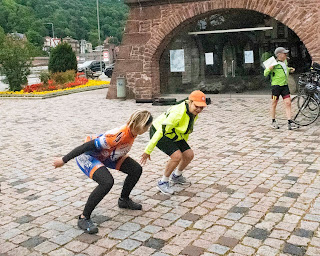Docked this morning in Ludwigshafen am Rein in the city of Manheim, just a bit upriver on the banks of the Neckar River (a Rhine tributary) from our target this morning, Heidelberg.
Our ride was short, only about 17 miles, the first couple through the streets of Manheim. It was a bit difficult maneuvering the tandem, but we made it unscathed. Jeri and I hooked up with a very fast group after getting out of the city and cranked our way with them to Heidelberg.
At one point in the ride, we had to cross the Neckar River by ferry.


We crossed the Old Stone Bridge over the Neckar to enter the town and were immediately transported back a few hundred years.
Manheim was devastated during WWII and is relatively new. By contrast, Heidelberg was spared any significant bombing by the Allies and fared very well with minimal damage to its old architecture, and more importantly, the University of Heidelberg. University of Heidelberg is the oldest university in Germany, founded in 1386, and the 4thuniversity established in the HRE. One theory of why Heidelberg was spared was that there was a secret agreement between the RAF and the Luftwaffe to not bomb Heidelberg and Cambridge thus saving their extensive ancient libraries. This has never been proven.
Another important site is the Heidelberg Schloss (or castle) which sits atop a high hill (we know, we walked up it) overlooking the Neckar River and red roofs of the city of Heidelberg. The schloss dates back to the 13thcentury when there was an upper and lower castle. After the upper castle was destroyed by fire from a lightning strike in 1537, it was never resurrected. The lower castle is all that remains today. The lower castle saw military action in both the 30 Years War (1660’s), and the Nine Year’s War (1700). During the Nine Year’s War, the French completely destroyed the castle with artillery and mines. It was finally abandoned in the early 1700’s after yet another lightning strike. Much of the reason for its preservation came as a result of the Romantic Movement and interest sparked by the likes of Victor Hugo and (yes) Mark Twain (who spent time here, getting the inspiration for the name Huck Finn from the huckleberries found in the area).
Views from the castle wall were spectacular. The castle itself was in a state of ruin but beautiful just the same.
The basement of the castle housed the largest wine vat ever constructed, holding over 220,000 liters of wine. It was large enough to require steps and scaffolding to walk around it. I’m still not sure just why that was in this castle-pretty weird.
Castle viewing was followed by lunch at a real German beer hall where we dined on schnitzel, spätzle (noodles), and beer. A light lunch!
After an early dinner,
we took an excursion to visit the mechanical music museum by "choo choo train".
We figured it was going to be pretty hokey, especially after the train ride, but the museum was actually quite fascinating.
It was a huge collection of mechanical music (made even more interesting by a very animated guide) from very elaborate player pianos that could replicate an orchestra,
to very early phonographs (this was an Edison),
to a machine that played violins and piano,
and even an nightingale music box (that you could purchase for $2,000-$5,000)
After the cheering crowd chanted his name over and over, Rick was "coaxed" into demonstrating a hand cranked organ. He was quite a dashing organ-grinder; all that was missing was his monkey!
 |
| Don with a new friend |
The train ride on the way back to the boat through Rudesheim was a nice end to a day of mostly touring. Tomorrow we have a long day of cycling-hopefully 60ish miles through castle country.

















































No comments:
Post a Comment